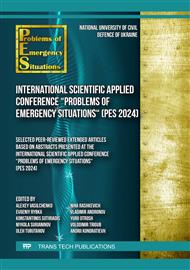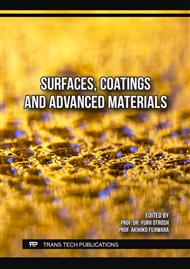[1]
DSTU B V.2.7-181:2009 Construction materials. Alkaline cements. Technical conditions. Kyiv, Ministry of Regional Development of Ukraine, 2009.
Google Scholar
[2]
DSTU B V.2.7-25:2011 Construction materials. Heavy alkaline concrete. Technical conditions. Kyiv, Ministry of Regional Development of Ukraine, 2011.
Google Scholar
[3]
J.L. Provis, S.A. Bernal, Milestones in the analysis of alkali-activated binders. Journal of Sustainable Cement-Based Materials. 4 (2) (2014) 74–84.
DOI: 10.1080/21650373.2014.958599
Google Scholar
[4]
J.L. Provis, Alkali-activated materials. Cement and Concrete Research. 114 (2018) 40–48.
DOI: 10.1016/j.cemconres.2017.02.009
Google Scholar
[5]
P.O. Awoyera, et al., Alkali activated binders: Challenges and opportunities. Materials Today. 27 1 (2020) 40–43.
DOI: 10.1016/j.matpr.2019.08.199
Google Scholar
[6]
J.L. Provis, S.A. Bernal, Geopolymers and Related Alkali-Activated Materials. Annu. Rev. Mater. Res. 44 (2014) 299–327.
DOI: 10.1146/annurev-matsci-070813-113515
Google Scholar
[7]
TU U 23.5 - 02070909 - 001:2016 "Aluminium silicate alkaline binder", Ukraine.
Google Scholar
[8]
TU U 23.6-41182689-001:2017 "Mixtures with special performance properties based on geopolymers", Ukraine.
Google Scholar
[9]
L. Bodnarova, et al. Nano-structured alkaline aluminosilicate binder by carbonate mineral addition. Solid State Phenomena. 276 (2018) 192–197.
DOI: 10.4028/www.scientific.net/ssp.276.192
Google Scholar
[10]
V. Kyrychok, P. Kryvenko, S. Guzii, Influence of the СaО-containing modifiers on the properties of alkaline alumosilicate binders. Eastern-European Journal of Enterprise Technologies. 2(6-98) (2019) 36–42.
DOI: 10.15587/1729-4061.2019.161758
Google Scholar
[11]
S. Guzii, et al., Influence of Basic Oxides Ratio Li2O/Al2O3, SiO2/Al2O3 and H2O/Al2O3 on Physical, Rheological and Colloidal-Chemical Properties of Lithium Containing Alumosilicate Suspensions in the System xLi2O-Al2O3-nSiO2-mH2O. Materials Science Forum. 1038 (2021) 193–202.
Google Scholar
[12]
P. Krivenko, et al., Intumescent fireproof coatings based on zeolite-like cement matrices. ce/papers. 6(5) (2023) 923–929.
DOI: 10.1002/cepa.2214
Google Scholar
[13]
F. Winnefeld, et al., Influence of slag composition on the hydration of alkali-activated slags. Journal of Sustainable Cement-Based Materials. 4 (2) (2015) 85–100.
DOI: 10.1080/21650373.2014.955550
Google Scholar
[14]
P. Kryvenko, et al., High Strength Alkali Activated Slag Cements with Controlled Setting Times and Early Strength Gain. Advanced Materials Research. 1100 (2015) 4–49.
DOI: 10.4028/www.scientific.net/amr.1100.44
Google Scholar
[15]
Y. Zabulonov, et al., New sorbents and their application for deactivation of liquid radioactive waste. LWRT 2022. LNCE 469 (2024) 126–136.
DOI: 10.1007/978-3-031-55068-3_14
Google Scholar
[16]
S. Guzii, B. Zlobenko, Application of alkali activated cements for immobilization of dry low-level radioactive waste containing copper ferrocyanide. Technology transfer: fundamental principles and innovative technical solutions. (2023) 3–8.
DOI: 10.21303/2585-6847.2023.003200
Google Scholar
[17]
T.O. Kiose, L.A. Raskola, Radiokhimiya z osnovamy radioekolohiyi. Radiatsiynyy vplyv na biolohichni ob'yekty: praktykum dlya studentiv f-tu khimiyi ta farmatsiyi. Odesa: Odes. nats. un-t im. I. I. Mechnykova. (2022) 140 [in Ukrainian].
Google Scholar
[18]
GOST 29114-91 Radioactive waste. Method for measuring the chemical stability of solidified radioactive waste by long-term leaching.
Google Scholar



